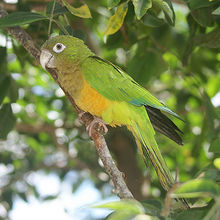Caatinga parakeet
| Caatinga parakeet | |
|---|---|

| |
| In Brazil | |
| Scientific classification | |
| Kingdom: | Animalia |
| Phylum: | Chordata |
| Class: | Aves |
| Order: | Psittaciformes |
| Family: | Psittacidae |
| Genus: | Eupsittula |
| Species: | E. cactorum
|
| Binomial name | |
| Eupsittula cactorum (Kuhl, 1820)
| |
The Caatinga parakeet (Eupsittula cactorum) or cactus parakeet or Cactus conure is a species of parrot in the family Psittacidae. It is endemic to the Caatinga region in north-eastern Brazil.
The Caatinga Parakeet is a parakeet that is found in the regions of Cerrado and Caatinga regions. Due to the environment that the Caatinga Parakeet live in their diet mainly consists of dryland vegetation of the regions of Caatinga. These Parakeets are often sold as pets in markets or are illegally traded across the countries and in the regions. The Caatinga Parakeet is a colorful bird. Both male and female birds are generally a green and yellow avian. The immature parakeet is generally paler than their mature counterparts. Their head, face, and chest area are a brown color while their abdominal regions are orange and the tail is tipped with blue.[2]
Environment[]
The Caatinga parakeet natively inhabits the Caatinga region of Brazil, which is in the Northeastern portion of Brazil. The environment in this region is a “semi- desert.” There are seasonal savannahs and dry forests in this area of Brazil.[3]
Diet[]
Due to the environment the Caatinga parakeet populates, their diet mainly consists of cactus seeds, fruits and berries which can be found in the desertous terrain of the Caatinga area. The parakeets are also known to forage crops such as rice, corn, and grapes.[3]
Conservation[]
The Cactus parakeet is not considered to be an endangered species of bird. Though it has an unknown population size, this parakeet species has a stable population.[4]
Subspecies[]
There are two types of subspecies of Eupsittula cactorum:
Eupsittula cactorum cactorum[]
This subspecies of parakeets are found in Bay all the way to the San Francisco River and to the northeastern parts of Minas Gerais, Brazil. This is the nominal subspecies of the Cactus parakeets.[5][3]
Eupsittula cactorum caixana[]
As for this subspecies it is found on the left side of the San Francisco River. They inhabit the northeastern parts of the Bay all the way to Maranhão. This subspecies is considered to be an endangered subspecies of the Cactus parakeets. The parakeet's appearance tends to be lighter in color and have a yellow abdominal region instead of orange, when compared to the nominal subspecies.[5][3]
References[]
- ^ BirdLife International (2016). "Eupsittula cactorum". IUCN Red List of Threatened Species. 2016: e.T22685748A93085356. doi:10.2305/IUCN.UK.2016-3.RLTS.T22685748A93085356.en. Retrieved 11 November 2021.
- ^ "Cactus Conure (Eupsittula cactorum) | Parrot Encyclopedia". www.parrots.org. Retrieved 2021-09-17.
- ^ a b c d "Cactus Parakeet (Eupsittula cactorum) - Exotic birds". Pets. 2017-09-19. Retrieved 2021-11-27.
- ^ "Cactus Parakeet (Eupsittula cactorum) - BirdLife species factsheet". datazone.birdlife.org. Retrieved 2021-11-27.
- ^ a b "Cactus Conures aka Caatinga Parakeets | Beauty of Birds". www.beautyofbirds.com. Retrieved 2021-11-27.
Further reading[]
- Oliveira, Maria Madalena S.; Araújo, Nayone L.L.C.; Raposo, Ana Cláudia S.; Torezani, Josiano C.; Menezes, Íris Daniela S.; Oriá, Arianne P. (27 February 2019). "Reference Values for Selected Ophthalmic Diagnostic Tests in the Caatinga Parakeet (Eupsittula Cactorum) and Yellow-Chevroned Parakeet (Brotogeris Chiriri)". Avian Biology Research. 10 (4): 211–217. doi:10.3184/175815617X14951979279286. S2CID 90782607.
- Martins, Bruno Araujo; Rodrigues, Giovanna Soares Romeiro; de Araújo, Carlos Barros (April 2018). "Vocal dialects and their implications for bird reintroductions". Perspectives in Ecology and Conservation. 16 (2): 83–89. doi:10.1016/j.pecon.2018.03.005.
- de Oliveira, Wallisson Sylas Luna; de Faria Lopes, Sérgio; Alves, Rômulo Romeu Nóbrega (11 June 2018). "Understanding the motivations for keeping wild birds in the semi-arid region of Brazil". Journal of Ethnobiology and Ethnomedicine. 14 (1): 41. doi:10.1186/s13002-018-0243-6. PMC 5996533. PMID 29891010.
External links[]
- World Parrot Trust Parrot Encyclopedia - Species Profiles
- Cactus parakeet: Photos, sounds from The Birds of the Interior of Ceará, Brazil
- IUCN Red List least concern species
- Eupsittula
- Birds of the Caatinga
- Endemic birds of Brazil
- Parrots of South America
- Birds described in 1820
- Parrot stubs
